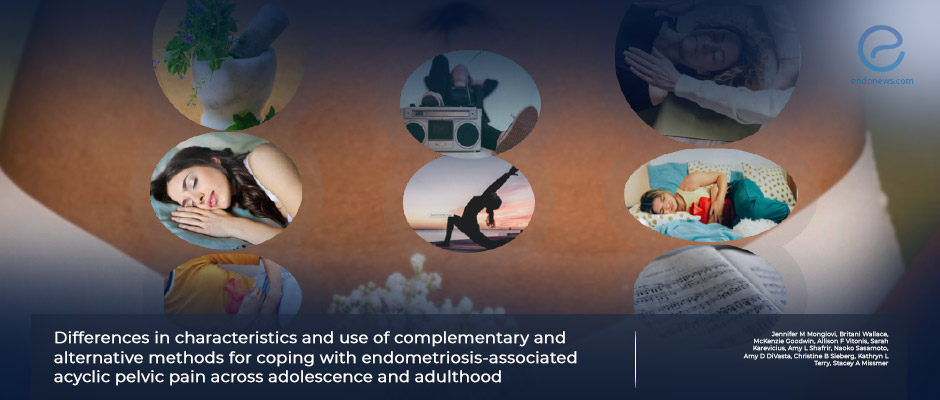Complementary and alternative therapies for managing acyclic pelvic pain in women with endometriosis
Feb 12, 2024
Endometriosis patients may use different complementary and alternative treatment modalities to cope with acyclic pelvic pain.
Key Points
Highlights
- Several complementary methods such as pain medication, relaxation, lying down, music, massage, hot bath, ice, heating pad, bowel movement, urination, laxative/enema, meditation, injection, and TENS unit are used to eliminate or reduce endometriosis-associated acyclic pelvic pain.
Importance
- Pelvic pain due to endometriosis is so severe that women may need to consult alternative methods other than routine medical and surgical modalities.
What’s done here?
- A longitudinal cohort study aimed to assess complementary and alternative therapies and their perceived efficacy in managing endometriosis-associated acyclic pelvic pain in patients with surgically confirmed endometriosis.
- Questionnaires on behavioral and reproductive factors, and endometriosis-specific points about pelvic pain, its severity, frequency, and pain interference, were applied.
- Pain medication, relaxation, lying down, music, massage, hot bath, ice, heating pad, bowel movement, urination, laxative/enema, meditation, and injection, were considered as the complementary options.
- Yoga, physical activity, acupuncture, and sleep were also added to the questionnaire in 2013.
- The study population was divided into three depending on the WHO definition of the age of adolescence [adults (>25), young adults (18–24), and adolescents (<18)].
- Factors that exacerbated acyclic pelvic discomfort (sitting-standing, stress, full-meal, bowel movements, full bladder/urination, exercise, coughing/sneezing, intercourse, orgasm,..) were also asked.
Key results:
- 357 adolescents, young adults, and adults with surgically-confirmed endometriosis who had persistent acyclic pelvic pain in the last 3 months were included.
- Most of the patients were found to have superficial endometriosis and stage I/II disease.
- Endometriosis-associated acyclic pelvic pain was often severe, experienced weekly, and resulted in abstinence from school or work.
- Approximately 4-8 complementary or alternative options were preferred for the management of acyclic pelvic pain by most of the participants. Sleep and music by adolescents, laxatives/enema use by young adults, and yoga by adults were preferred more frequently.
- All age groups used a heating pad as the most common coping method with acyclic pelvic pain.
- Pelvic pain was worsened by stress, constipation, and exercise.
Lay Summary
The quality of life in women with endometriosis is affected depending on the symptoms and signs of endometriosis such as dysmenorrhea, dyspareunia, chronic pelvic pain, and infertility. Because of different clinical spectrum and diagnostic delays, there is no optimum management method in all women with endometriosis. Expectant, medical, or surgical methods are personalized depending on the patient’s clinical presentation and gynecologic evaluation.
Mongiovi et al., from the United States, published a longitudinal cohort study titled “Differences in characteristics and use of complementary and alternative methods for coping with endometriosis-associated acyclic pelvic pain across adolescence and Adulthood” in Frontiers in Reproductive Health.
The authors aimed to assess complementary and alternative therapies utilized, and their perceived efficacy to manage endometriosis-associated acyclic pelvic pain following surgery in different age groups. They applied questionnaires including questions on behavioral and reproductive factors, as well as endometriosis-specific questions related to pelvic pain, its severity, frequency, and pain interference.
Approximately 4-8 complementary or alternative options were preferred for the management of acyclic pelvic pain by most of the participants. Sleep and music by adolescents, laxatives/enema use by young adults, and yoga by adults were preferred more frequently. Heating pad was the most common coping method with acyclic pelvic pain in all age groups. Pelvic pain was worsened by stress, constipation, and exercise according to questionnaire results.
“Future studies should aim to provide information that will further inform decisions in making care plans for managing endometriosis-associated pain that is effective, accessible, and tailored to the preferences of the patient.” the authors added.
Research Source: https://pubmed.ncbi.nlm.nih.gov/38260050/
endometriosis adolescent pelvic pain complementary therapies dysmenorrhea pain triggers pain remediators

